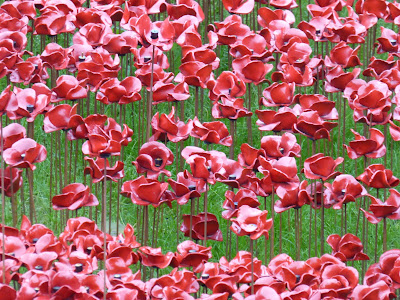 |
| Blood Swept Lands and Seas of Red, London |
From speaking to people before the installation began, I'm not sure that most thought it was a good or worthwhile idea, but as the work progressed, it became clear that this was going to be an incredibly effective and popular tribute.
The artists behind it were Paul Cummins and Tom Piper. Paul was apparently inspired by a line in the will of a man who died at Flanders, which read 'The Blood Swept lands and seas of red, where angels fear to tread.' It provided the name and the vision for the installation.
 |
| Blood Swept Lands and Seas of Red, London |
Between July and Armistice Day, the 11th of November, some 8000 volunteers 'planted' 888,246 handmade ceramic poppies into the moat of the Tower of London. The number was specific, one for each British or colonial military death.
Once the installation ended the day afterwards, the poppies would be removed and sold, to raise money for service charities. Over £15 million was raised.
 |
| Blood Swept Lands and Seas of Red, London |
Of course, simple number is one thing, but showing these as real people is quite another. The official method of doing this was to allow the public to nominate names of those who had died to be remembered.
 |
| Blood Swept Lands and Seas of Red, London |
Every evening at sunset, 180 names were called out in a Roll of Honour, followed by the Ode of Remembrance and The Last Post.
For me though, the more moving aspect was one that hadn't been planned. As we walked along the edge of the moat, we could see that hundreds of individual tributes had been left attached to the railings.
Some were just names, some were standard poppies or poppy crosses, but there were also photos, poems, and stories of loved ones who had died. These impromptu and very personal remembrances made the whole thing more meaningful.
 |
| Blood Swept Lands and Seas of Red, London |
Some 4 million or so people came to visit the poppies, but many more realised too late that this was something worth seeing, leading to many calls for the installation to remain after Armistice Day.
However, the artist strongly resisted this, making the point that the very fact of the installation being temporary, represented transient nature of human beings. Certainly the way that the poppies were taken away before people were ready for it, seemed to be very fitting, given that they were symbolising men whose lives were cut short.
 |
| Blood Swept Lands and Seas of Red, London |
 |
| Blood Swept Lands and Seas of Red, London |
 |
| Blood Swept Lands and Seas of Red, London |
 |
| Blood Swept Lands and Seas of Red, London |
No comments:
Post a Comment
We like to hear from you too, so please leave us a message here. We are also happy to answer any questions if we can help. Comments are moderated so will not appear straight away and there could be some delay in replying if we are travelling.